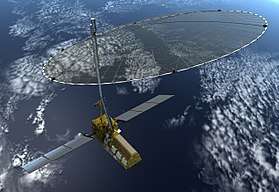NISAR (satellite)
 Artist concept of the NASA-ISRO Synthetic Aperture Radar (NISAR) satellite in orbit. | |
| Mission type | Radar imaging |
|---|---|
| Operator | NASA · ISRO |
| Website |
nisar www |
| Mission duration | 3.25 years[1][2] |
| Spacecraft properties | |
| Launch mass | 2,800 kg (6,200 lb) |
| Start of mission | |
| Launch date | 2020-21 (planned)[3][4] |
| Rocket | Polar Satellite Launch Vehicle |
| Launch site | Satish Dhawan Space Center |
| Orbital parameters | |
| Reference system | Geocentric[1] |
| Regime |
Low Earth Sun-synchronous[5] |
| Altitude | 747 kilometers (464 mi) |
| Inclination | 98.5°[5] |
 | |
The NASA-ISRO Synthetic Aperture Radar (NISAR) mission is a joint project between NASA and ISRO to co-develop and launch a dual frequency synthetic aperture radar satellite. The satellite will be the first radar imaging satellite to use dual frequency and it is planned to be used for remote sensing to observe and understand natural processes on Earth.
Description
The NASA-ISRO Synthetic Aperture Radar, or NISAR satellite, will provide an unprecedented detailed view of Earth by using advanced radar imaging. It is designed to observe and take measurements of some of the planet's most complex processes, including ecosystem disturbances, ice-sheet collapse, and natural hazards such as earthquakes, tsunamis, volcanoes and landslides.[6]
Under the terms of the agreement, NASA will provide the mission's L-band synthetic aperture radar (SAR), a high-rate communication subsystem for science data, GPS receivers, a solid state recorder, and a payload data subsystem. ISRO will provide the satellite bus, an S-band synthetic aperture radar, the launch vehicle and associated launch services.[7]
Data collected from NISAR will reveal information about the evolution and state of Earth's crust, help scientists better understand our planet's processes and changing climate, and aid future resource and hazard management. The mission is a partnership between NASA and ISRO.[3]
The satellite design will make use of a large deployable mesh antenna and will operate on dual L band and S band.[3] The 12-meter aperture mesh reflector will be supplied by Astro Aerospace, a Northrop Grumman company.[8] The satellite will be launched from India aboard an Geosynchronous Satellite Launch Vehicle.[9][10][11] The satellite will be 3-axis stabilised and is planned to be launched into a Sun-synchronous dawn to dusk orbit with a mission life of 3 years.[1] The project has passed the first stage of the design validation phase and has been reviewed and approved by NASA.[12]
Shared cost of project for ISRO is about ₹788 crore (US$110 million) and for NASA it is about US$808 million.[10][11]
Payload
- L-band (24-centimeter wavelength) polarimetric SAR, to be produced by NASA.
- S-band (12-centimeter wavelength) polarimetric SAR, to be produced by ISRO.[12]
See also
References
- 1 2 3 "Satellite Programme: NASA ISRO-Synthetic Aperture Radar". World Meteorological Organization. Retrieved 2 July 2014.
- ↑ "Optimization of Debris Shields on the NISAR Mission's L-Band Radar Instrument" (PDF). conference.sdo.esoc.esa.int. ESA Space Debris Office. Retrieved 21 July 2017.
- 1 2 3 "NASA-ISRO Synthetic Aperature Radar". Jet Propulsion Laboratory. Retrieved 24 January 2017.
- ↑ Bagla, Pallava. "The First Ever Satellite Being Jointly Built By NASA And ISRO Will Do This". Retrieved 19 May 2017.
- 1 2 "NISAR Mission".
- ↑ "NASA-ISRO SAR Mission (NISAR)". Jet Propulsion Laboratory. Retrieved 2 July 2014.
- ↑ "U.S., India to Collaborate on Mars Exploration, Earth-Observing Mission". NASA. Sep 30, 2014. Retrieved 8 October 2014.
- ↑ http://globenewswire.com/news-release/2015/10/30/781817/10154634/en/NASA-Jet-Propulsion-Laboratory-Selects-Northrop-Grumman-s-Astro-Aerospace-for-NISAR-Reflector.html
- ↑ "NASA-ISRO Synthetic Aperture Radar Radar Satellite (NI-SAR)". Retrieved 2 July 2014.
- 1 2 "Rajyasabha Q.No. 2223, Session:243 "JOINT PROJECT BETWEEN NASA AND ISRO"" (PDF). 3 August 2017.
- 1 2 "Joint Project between NASA and ISRO". Press Information Bureau, Government of India. 3 August 2017. Retrieved 3 August 2017.
- 1 2 "Isro's instrument design passes Nasa review". The Times of India. Retrieved 2 July 2014.


